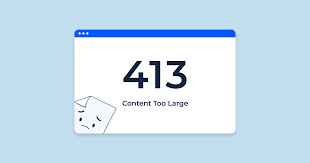Unraveling the 413 Payload Too Large Error: Causes and Solutions – Your Comprehensive Guide

Unraveling the 413 Payload Too Large Error Causes and Solutions - Your Comprehensive Guide
Introduction
In the vast realm of the internet, error codes are like signposts guiding us through the digital landscape. Among these codes, the “413 Payload Too Large” error stands out as a message that the data you’re trying to send to a server is exceeding the allowed size limit. In this comprehensive guide, we’ll delve into the intricacies of the 413 error, explore its underlying causes, and provide you with a step-by-step guide to effectively troubleshoot and resolve it.
Understanding
The “413 Payload Too Large” error is an HTTP status code that indicates that the server refuses to accept the request because the payload, such as the data you’re trying to send, exceeds the size limit set by the server’s configuration.
Common Reasons for the 413 Error
Data Exceeding Limit:
The primary cause of a 413 error is attempting to upload or send data to the server that surpasses the maximum payload size permitted.
Server Configuration:
The server’s configuration settings dictate the maximum allowed payload size for different types of requests, and the error occurs if this limit is breached.
Resolving the 413 Payload Too Large Error:
Step-by-Step Guide
Check Payload Size:
Review the data you’re trying to send or upload and determine its size. Ensure it doesn’t exceed the maximum payload size allowed by the server.
Compress Data:
If the data you’re sending includes large files or text, consider compressing the data before sending it. This can significantly reduce the payload size.
Split Data:
If the payload size is still too large, consider splitting the data into smaller parts and sending them sequentially.
Verify Server Limits:
Consult the server documentation or contact your server administrator to determine the maximum payload size allowed for different types of requests.
Use Chunked Transfer-Encoding:
If you’re a developer, consider using the “Chunked Transfer-Encoding” method to send data in smaller chunks instead of a single payload.
Optimize Images and Files:
If you’re sending images or files, ensure they are appropriately optimized to reduce their size without compromising quality.
Use Cloud Storage:
If possible, upload large files to cloud storage services and provide links to those files instead of sending them as part of the payload.
Contact Support:
If the error persists despite your efforts, reach out to the website’s support team or your server administrator for assistance.
Upgrade Server Resources:
If your server frequently encounters payload size limitations, consider upgrading your server resources to accommodate larger payloads.
Conclusion
Confronting the 413 Payload Too Large error might feel like hitting a roadblock, but armed with an understanding of its origins and potential solutions, you’re now well-equipped to overcome it. Whether it’s about compressing data, splitting payloads, or optimizing files, this guide empowers you to navigate the intricacies of data transfer with confidence. Remember, adaptability and a proactive approach are key to resolving the 413 error and ensuring seamless data exchange within your online interactions.
For More Related Articles Browse Our Website Blogster.pk
For social Connection You can also Visit and follow our Social media Platforms
Facebook , Instagram, Linkedin, Pinterest, Quora, Twitter, Youtube.





